This was published 1 year ago
World's best beaches: The eight we love the most
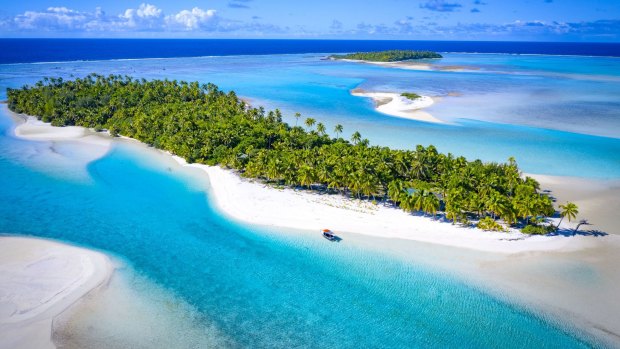
One Foot Island in Aitutaki Lagoon, Cook Islands.Credit: Cook Islands Tourism
Picture paradise. It's a beach, isn't it? It doesn't matter that "paradise" is an overused stereotype, an overused concept, something subjective and entirely unattainable. Still, paradise to so many of us is a beach.
As Australians, we can't help but crowd around our own beaches, we start to feel uneasy when we aren't near. It's no surprise to find that even when we travel we're drawn to them.
They're the places where local life gathers and flourishes, the places where vibrant food and bar cultures spill over onto the sand, the places where spectacular storms lash forbidding coastline, the places that connect us to family.
Here, Traveller writers reveal the stretches of sand that have most captured their hearts, the beach they'd always return to, or dream of doing so paradise, if you will. Only in these instances, attainable. - Ben Groundwater
PLAYA ZURRIOLA, SAN SEBASTIAN, SPAIN
By Ben Groundwater
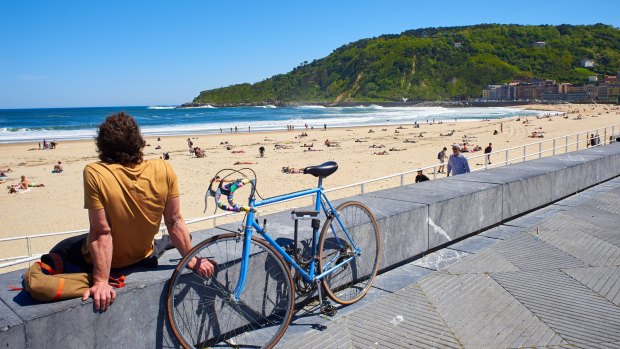
Credit: iStock
VITAL STATISTICS Golden sand, 800 metres long and 40 metres wide with water temperatures ranging between 13 to 22 degrees Celsius.
WHY I LOVE IT Is Playa Zurriola the best beach in the world? In all honesty, it may not even be the best beach in San Sebastian. Plenty of visitors would award that title to Playa de la Concha, the perfect crescent of white sand to the west of Zurriola, a gorgeous beach in the shadow of twin mountains, ringed by some of Spain's most expensive real estate. However, Zurriola, for me, at least, is the greatest.
This is San Sebastian's more egalitarian alternative to ritzy Concha, the beach where the action is, the beach where the character is, the beach where you'll find the locals, and the surfers, and people from every single walk of life imaginable. I know this beach intimately as I watched it change over the course of a year when I lived in Gros, the neighbourhood overlooking Zurriola.
There's a big sea wall at the eastern end of Zurriola, and it's one of my favourite places in the world. You sit on that wall in the late afternoon, grab a good spot among the groups of teenagers, fitness nuts, tourists, and pilgrims coming down from the nearby Camino del Norte. You sit there and watch the action on the beach, the sunbathers, the volleyball players, the surfers, the walkers, the kids, the retirees, all the naked people down the far end. And you watch as the sun slowly sets on this scene with the lights of San Sebastian begin to sparkle as the crowds drift off towards the pintxos bars to drink and eat.
MAKE IT HAPPEN Playa Zurriola is best (and busiest) in the warmer months, from June to September. It's free to visit, though if you want a deck chair you'll have to pay (this is Europe, after all). See sansebastianturismoa.eus
NINETY-MILE BEACH, GIPPSLAND, VICTORIA, AUSTRALIA
By Lee Tulloch
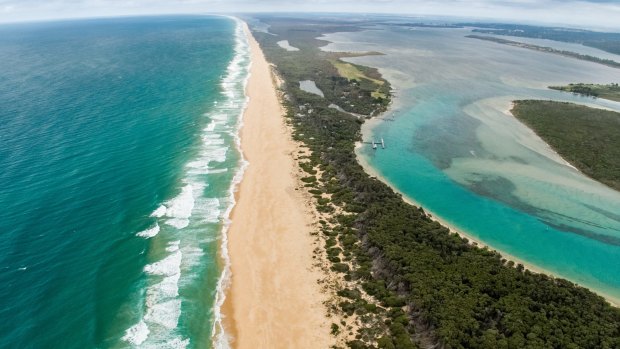
Credit: Visit Victoria
VITAL STATISTICS White sand with a length of 151 kilometres and an average water temperature in summer of 18.7 degrees.
WHY I LOVE IT Every summer, our small family would pack up the Holden and head for the camping ground at Lake Tyers in Victoria, where the Gippsland Lakes meet Bass Strait. This small community, which included an Aboriginal mission, was merely one point of access to the fourth longest, uninterrupted beach in the world, edged with white sand dunes as far as the eye could see. The sea itself was unfriendly to inexperienced swimmers and surfers with hazardous rips and currents, so we kids paddled, splashed and learnt to swim in the kinder waters of the lake.
My most vivid childhood memories are of sitting in the dunes at dawn as my father, dressed in waders, threw lines into the surf and returned with tranches of flathead, which he fried up for breakfast. We ran free-range in gangs, hiding out in the dunes, coming back to the camp for "tea", covered in sand and salt, and often, unfortunately, sunburnt, which required the application of cold tea bags. There were sharks, snakes and ticks, but somehow we survived to return another year. These blissful childhood holidays caused me to develop a snobbery about beaches. Any beach that wasn't pristine, empty of people and lacked towering sand dunes was not worth stepping on. I still feel this way.
MAKE IT HAPPEN Golden sand with 151 kilometres of uninterrupted beach, even in high summer. It can be reached from the South Gippsland Highway via the towns of Woodside Beach, Seaspray, Golden Beach or Loch Sport and Lakes Entrance. See visitgippsland.com.au
CHESTERMAN BEACH, TOFINO, BRITISH COLUMBIA, CANADA
By Brian Johnston
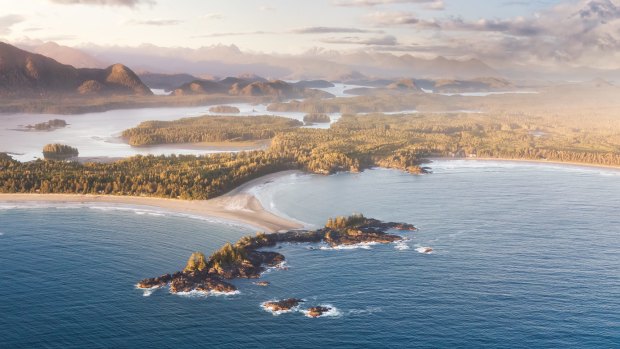
Credit: iStock
VITAL STATISTICS Grainy grey-brown sand scattered kelp and tossed-up tree trunks, 2.7 kilometres long, and 100 metres wide with the warmest water temperature in July of 12.9 degrees.
WHY I LOVE IT Fishing and logging village Tofino sits on a peninsula between ocean, dense forest and snow-dusted mountains on Vancouver Island in British Columbia, and is the ultimate beach destination for those who'd rather be thrilled than tanned. This is Canada's storm-watching capital, where I love to go in the winter's depths, hoping for black clouds, ferocious winds and huge swells that come roaring in from the ungentle North Pacific.
Chesterman Beach receives the full-frontal storm effect: you can feel the sand shake as waves crash. The huge, mossy cedar trees that overlook the beach groan and sway. Your cheeks will tingle and exhilaration blossom. A walk on the beach is even better when the wind bends you double and rain lashes your face.
At low tide, explore rock pools where starfish and anemones lurk. Low tide also reveals a sand spit that lets you walk out to Frank Island – at least in calm weather – and admire the beach view against Tofino's mountain backdrop. What I love most is that a stay here isn't an endurance test. When gales rise and clouds swirl it's time to get back outside again onto the sands as breakers boom on jagged rocks. Rain, rain, go away? I don't think so. Bring it on.
MAKE IT HAPPEN The best storm season runs November to February, with a dozen storms a month. Chesterman Beach is a top surfing and sea-kayaking destination for those who dare, and has a notable surf school. See tourismtofino.com
HAHEI BEACH, COROMANDEL PENINSULA, NORTH ISLAND, NEW ZEALAND
By Lauren Quaintance
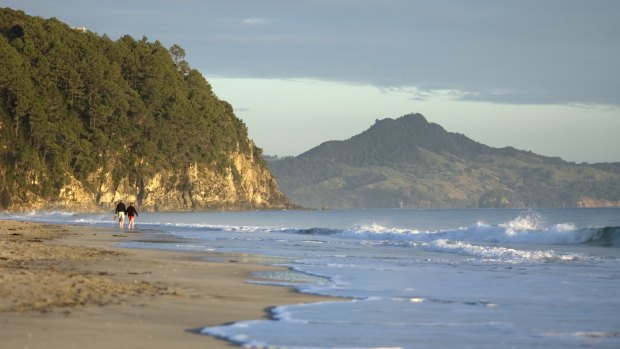
Credit: iStock
VITAL STATISTICS White-pink sand and 1.67 kilometres long, the warmest water temperature at Hahei (pronounced Har-hey) is 19 degrees in March.
WHY I LOVE IT While Hahei is undoubtedly beautiful, for me it has a kind of magnetism, a sense of connection to something greater. It's not just that I've been coming here for 30 years, first as a teenager camping in a kind of tent city on the lawn of someone's family bach (that's Kiwi for holiday home or beach house) . Or even that I got engaged here under the boughs of a flowering pohutukawa tree. It's what the Maori people poetically call "turangawaewae" which literally means "a place to stand", a place to be grounded in nature. There's nothing quite like an aimless wander on that long stretch of beach or clambering up the headland to take in the view of the wind-whipped South Pacific Ocean.
While Hahei is popular with Kiwis, you don't need to be a local to enjoy it. Book a house via a listings site or a cabin or campsite at the grandly named Hahei Beach Resort which has a fantastic position overlooking the beach. There's also a well-equipped general store and ice cream parlour, a couple of cafes and a brew bar. While you're there hire kayaks and paddle around to Cathedral Cove, a highly photographic limestone arch, or dig a hole at nearby Hot Water Beach and let water from underground thermal springs lap at your feet.
MAKE IT HAPPEN February is the best time for long periods of settled weather while brisk walks on the beach can be enjoyable, too, sans the crowds. Hahei is 175 kilometres from Auckland and you will need a car. See thecoromandel.com
IPANEMA, RIO DE JANEIRO, BRAZIL
By Rob McFarland
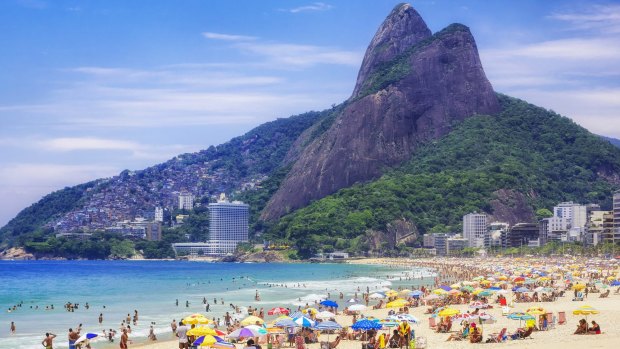
Credit: iStock
VITAL STATISTICS A broad, two-kilometre-long swathe of powder white sand with water temperatures range from around 22 degrees in August to 26 in March.
WHY I LOVE IT Because for Rio's fun-loving residents (known as cariocas), it's not just a beach – it's the city's main social hub. Some come to work out, utilising the free outdoor gyms dotted along thepromenade, others come to play spirited games of football, volleyball and beach tennis. You'll find everything from flexing bodybuilders and flirting teenagers to squealing toddlers and napping nannas.
Arrive beach-fit and bronzed because everyone else will be lithe, tanned and scantily clad.
If you're visiting on a weekend in summer, pitch up early to snag a good spot, rent a beach chair and umbrella (you'll be glad of the shade) and settle in for an entertaining day of people-watching punctuated by refreshing plunges into the Atlantic Ocean. Thirsty? A vendor selling an ice-cold Brahma beer will be along momentarily. Hungry? Grab a sizzling prawn skewer from an outdoor grill on the promenade.
When you're ready for a break, the adjacent neighbourhood of Ipanema has countless bars, restaurants and upmarket boutiques. It's compulsory to visit Garota de Ipanema, the bar where Tom Jobim and Vinicius de Moraes wrote The Girl from Ipanema. Sadly, beneath Rio's carefree facade, there are perils. Petty crime is rife (particularly on the beach), so either bring a waterproof bag for valuables, or, better still, don't bring them at all. And the sea can be rough, with powerful waves, vicious rips and variable water quality. Look for warning signs and only swim where the locals go. At dusk, buy a lime-infused caipirinha from a beach bar, find a spot on the headland and join in the applause as the sun slides behind the volcanic peaks of the Dois Irmãos (Two Brothers) mountains.
MAKE IT HAPPEN December to March is peak season with New Year's Eve and Carnival (normally mid to late-February) especially frenetic. For less crowds, heat and humidity, visit in November or April. See visitbrasil.com
ONE FOOT ISLAND, AITUTAKI, COOK ISLANDS
By Craig Tansley
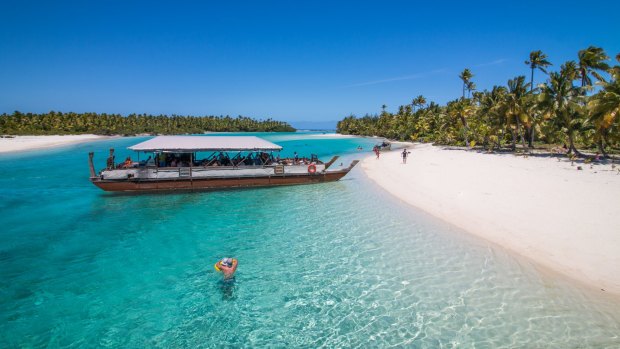
VITAL STATISTICS White fine sand that feels like silica, 500 metres long, 20 metres wide, average annual water temperature of 26 degrees.
WHY I LOVE IT How couldn't you love One Foot Island? One of 15 tiny uninhabited islets (motu) in one of the South Pacific's most celebrated lagoons (only Bora Bora gets more plaudits), you can only reach One Foot Island by boat (speed-boat, traditional vaka or hobie-cat). I found it on a day-long lagoon cruise 22 years ago, now I never skip One Foot Island when I visit the Cook Islands, no matter the cost, or inconvenience. And while it's now a regular stop on most Aitutaki travellers' itineraries, it's never hard to find your own piece of sand. I prefer low tide, that's when you can wade easily across the water to a sandbar 200 metres wide which locals call paradise. And at low tide, the channel between neighbouring island, Tekopua, is more pronounced, so you see the complete range of blue water this part of Polynesia is famous for.
I like to hold my breath under the water in the channel with my eyes open and slowly make my way to the surface, watching the light change. The channel's the best place for swimming because it's deep – about four metres - but so clear you can see the sea stars and sea cucumbers on the bottom. There are fish and the occasional turtle, though the barrier reef right round the lagoon keeps out the biggest sea creatures (so I always feel safe). There's thatched roof huts beneath coconut trees that shade the beach – the lagoon cruise island crew cook a barbecue here most days, then they play guitars and sing as we all swim, or lie down in the shade of all those coconut trees.
MAKE IT HAPPEN Visit year-round, though rain is more likely, take sunscreen and a hat, and plenty of water as here's nothing for sale on the island. Water taxis, hobie-cat tours and lagoon cruises are available seven days. See cookislands.travel
MALCAPUYA ISLAND BEACH, CULION, PHILIPPINES
By Catherine Marshall
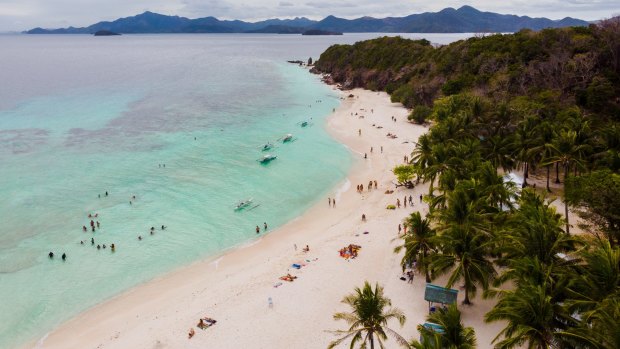
Credit: iStock
VITAL STATISTICS Chalk white sand, 300 metres-long with water temperatures ranging from 31 degrees in July and 27 degrees in February.
WHY I LOVE IT Malcapuya Island appeared deserted the day I sailed there in a banca (outrigger) from nearby Culion Island – once the world's largest leprosarium. That was 12 years ago, and still I dream of it: glimpsing giant clams below as we approached the island's western shoreline, wading across a rocky seabed, tracing a path through thickets of scrub and palm trees, emerging onto the dazzling expanse of alabaster sand and diaphanous sea. I'd passed a house on my walk – the only one on the island; my Filipino companions introduced me to the Tagbanua caretaker and his wife, the only two people living on the island. Huts and gazebos had been set up beneath palms on the beach, but there were few people about. The sand was velvety, the water sultry and replenishing. I lay in a hammock strung out between two palms and bathed in the castaway tranquillity.
By lunchtime a flotilla of banca had moored in the bay and deposited a cargo of local day-trippers. My companions and I picnicked on a pot of food prepared by the cook at our lodging on Culion. Later, I climbed the scarp at the northern end of the beach; from here the sea revealed its brilliance: translucent at its edges, deepening to cobalt in the distance and black where neighbouring islands cast their voluptuous shadows. Below me, the beach lay against the shoreline like a length of tossed silk.
MAKE IT HAPPEN The beach is at its best during the dry summer season, November to May. Pack a hat, sunscreen and water. Tribal Adventures' day and multi-day trips to Malcapuya Island depart from Coron with meals included. See tribaladventures.com
RADHANAGAR BEACH, HAVELOCK ISLAND, ANDAMAN AND NICOBAR ISLANDS, INDIA
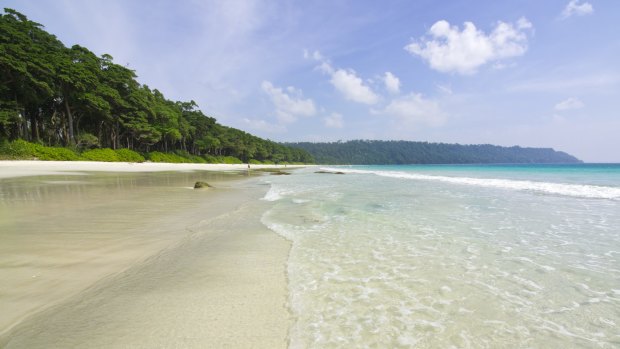
Credit: iStock
By Ute Junker
VITAL STATISTICS Golden sand, two kilometres long with the water temperature is a steady 28 to 30 degrees all year around.
WHY I LOVE IT The Andaman Islands are on the way to exactly nowhere. Scattered across the Indian Ocean between Myanmar and Sumatra and now belonging to India – a quirky legacy of British colonial rule - the only way you will get to discover these islands is if you make a dedicated trip. If you are a nature-lover, it is a trip you will never forget. I actually fell in love with the Andamans right here on Radhanagar Beach, one of Havelock Island's most popular beaches, which was conveniently just steps away from the resort where I was staying. Radhanagar – which the British insisted on referring to as "Beach No. 7" - is most famous for its blazing sunsets and yes, they do glow with a crazy beauty that tops just about anything I've seen elsewhere in the world. But that's not why I can't wait to get back to Radhanagar. It is what you will find in these crystal-clear waters that has me hooked. Snorkel out just a few minutes and you will find a reef teaming with life – from baby giant clams with glowing blue lips to elegant butterfly fish and huge schools of snapper, trevally and huge humphead parrot fish.
Even dugongs have been sighted off the beach. Not on my watch, unfortunately, but I do spy plenty of turtles – as in, legions of them. And not small specimens either. Every day during my stay I have the thrill of swimming with some of the largest turtles I have ever seen, as they drift from one bed of seagrass to the next, unperturbed by my presence.
MAKE IT HAPPEN The Andaman Islands are a year-round destination, best reached by direct flights from Kolkata or Chennai. See andamantourism.gov.in
FIVE MORE BEACHES WE LOVE
GRACETOWN BEACH, WA, AUSTRALIA
Gracetown Beach, in the heart of Western Australia's Margaret River region, on the right day, is an incredible surf beach. Visitors can grab a spot at North Point and be right in the action, watching as some of Australia's finest board-riders tackle the waves. See westernaustralia.com
GREY BEACH, PATAGONIA, CHILE
Grey Beach in Torres del Paine National Park, home to some of the most spectacular landscapes in Chile's deep south. It isn't just the snow-capped peaks looming above the lake that captivate – it is the sight of freshly-calved icebergs drifting past as you watch. See patagonia-chile.com
WHANGAPOUA BEACH, GREAT BARRIER ISLAND, NEW ZEALAND
Reaching this uncrowded, white sand surf beach is an adventure. Take a four-hour ferry (or a 30-minute flight) from Auckland to Great Barrier Island. Then drive, cycle or hike to Whangapoua Campsite. Wade or swim across the creek or take the road with the creek crossing the more fun. See greatbarrier.co.nz
OUALIDIA BEACH, OUALIDIA, MOROCCO
For a respite from touring, head to Oualidia on Morocco's Atlantic coast, a 2.5-hour drive from Casablanca or Marrakesh. The fishing town itself is scruffy and nondescript but wealthy Moroccans hunker in chic ocean-gazing villas on the hillsides. See visitmorocco.com
ARROYO BURRO BEACH, US, CALIFORNIA
Eight kilometres west of ever-popular Santa Barbara, Arroyo Burro Beach is a local's secret, a hidden sandy bay cherished by surfers and locals who prefer to walk their four-legged friends off the leash. Order breakfast (at The Boathouse) right by the sand. See visitcalifornia.com
Sign up for the Traveller Deals newsletter
Get exclusive travel deals delivered straight to your inbox. Sign up now.